#serpentinized peridotite
Explore tagged Tumblr posts
Text

Ehehehe geology infodump time

Here, my friends, is a piece of the mantle of the earth.
This is peridotite with veins of serpentinite. This rock was born in the middle of the ocean in an oceanic ridge like where you find seafloor hydrothermal vents (aka black smokers) (ophiolite sequence babyyy) like these vv


Then the rock joined a mountain chain in the ocean that got smashed into the west coast of the North American continent and in the ensuing chaos, this rock ended up on the top of a mountain.
When I was on a field trip with my geology class and a couple of geo researchers, my teacher found this rock and the geologists were all geeking out over it. We used the rock in a class project and now that it is the end of the term I got to take this rock home!
#I'm still in intro geology so I'm still learning about this stuff#but this is the story the geologists on the trip deduced about this rock#geology#ophiolite sequence#serpentinized peridotite#it may be kinda ugly but this is the coolest rock I own#siletzia#oh yeah#fun fact: asbestos comes from serpentinite
18 notes
·
View notes
Text
ok so my lovely mutual @icarrymany dared me to post proof of my rock/min collection so this is his fault >:)
im not gonna go into depth on all of the samples bc 1. i dont remember the details on all of them lol and 2. it would take. forever
so instead ill talk a little abt one or two of them per section :3
first up: tumbled minerals!
i have a bunch more of these but after becoming a geology student they kind of piss me off bc raw minerals often look way cooler and tumbling removes the crystal habit (and also makes them harder for me to identify hgjhfd)



first image, from left clockwise: (possibly) blue lace agate, chrysocolla. labradorite, snowflake obsidian, moss agate, brown agate, and two samples of tigers eye
2nd image: up close picture of one of the tigers eye crystals, showing its lighter banding
3rd image: up close picture of the labradorite from a different angle, showing its pale green luster
my absolute favorite mineral ever is labradorite also!! i think its luster is gorgeous and ive heard it represents transformation and change, and i first got this sample back when i had just come out as trans :)
i dont really have a lot to say abt these unfortunately lol
anyway. next is fossils!!




1st image, clockwise from bottom left: trilobite cast fossil, tumbled stromatolite, dinosaur bone (? got this one at a mineral stall and the dude said it was a dino bone, didnt think to ask details lol), plant fossil, coral fossil, assorted fossil molds (mold as in taking the shape of something, not spores) in wackestone, mosasaurus tooth, crocodile (?) tooth, 2 ammonites, a turtle scute, a crinoid stem, and a (broken) orthoceras
2nd image: up close pic of the assorted fossil molds, which include horn corals (circular with ridges toward center, hole in middle), crinoid stems (cylindrical with ridges perpendicular to long sides), and shells
3rd image: up close pic of larger ammonite, with iridescent luster due to aragonite (a polymorph of calcite) replacing the calcite of the shell
4th image: up close pic of dubious tooth. i found this on a field trip about a year ago while looking for shark teeth. this is not a shark tooth. idk what it is. i think it might be from a crocodile but i havent been able to fully identify it lol
now.... raw minerals!!!!!






1st image, clockwise from left: moss agate, talc, serpentinite (this one is a metamorphic rock but i accidentally put it with the minerals and dont want to retake the pics. other geologists you may come kill me), two calcite samples, and a tiny topaz @ramones2 gave me
2nd pic: close up on the topaz crystal, which is light orange (if u leave these in the sun they get bleached and lose their color </3)
3rd pic: close up on one of the calcites. its crystals are a bit more squared and close-knit than the next calcite, and appear more white in color. there are also some small purple fluorite crystals mixed in. i traded with a classmate for this one lol
4th pic: close up on the other calcite. this ones crystals are more rounded and transparent.
5th pic: close up on the serpentinite. serpentinite is metamorphosed from peridotite, which makes up the earth's mantle (if youve ever heard that the mantle is actually green, that is true!! the green comes from olivine mostly, but also some pyroxenes). when peridotite is lifted up to the surface and comes into contact with water, olivine gets very unhappy and serpentinizes, or hydrothermally metamorphoses (water + some heat + olivine = cool as fuck snakeskin rock)
6th pic: another close up on the serpentinite, this time wet. you can see the serpent-like pattern a bit better.
finally: rocks :3




1st image, clockwise from bottom left: amphibolite, sedimentary rock with calcite vein (i dont remember what this one is lmao), malachite-bornite ore, iron-stained sandstone(?) with chalcedony/agate, phyllite, sandstone trace fossil of a burrow, and meteoric rock possibly with iron
2nd pic: close up on the ore, showing the malachite vein. it's almost powdery, with a gradient of light blue on the edges to teal in the center
3rd pic: another close up on the ore, showing the bornite vein. it's iridescent like an oil slick, with the main color being purple. this one is often called peacock ore for its colors :)
4th pic: . im gonna be honest i have no fucking clue bro. i think the mineral in it is agate/chalcedony (the lighter gray/white areas) and the red parts are an iron-stained sedimentary rock, but i forget if its siltstone or sandstone or smth else. idk. it looks cool.
bonus: extra pic of my rocks for further proof of collection

hope u enjoyed o7
#i finally had an excuse to ramble abt my rock collection THANK U BRIAN <333#i really should have written down somewhere what each sample was but. listen#i had. 5 different field trips for my geology classes this past semester#and half the time i didnt even ask what a rock was i just fucking took it HJFGBHD#if i really studied them i could probably figure out more reliably what some of them are#but i dont want to <3#at least not rn lol#ANYWAYS yeah#rawks 👍
11 notes
·
View notes
Text
gabbro, granite, diorite, volcanic breccia, tuff, pumice, andesite, basalt, carbonatite, trachyandesite, trachybasalt, rhyolite, lamproite, kimberlite, microcline, orthoclase, plagioclase, muscovite, biotite, chlorite, ophiolite, grossular garnet, hessonite, uvaroite, feldspar, sanidine, sunstone, moonstone, labradorite, indigo gabbro, tangerine quartz, strawberry quartz, rutilated quartz, tourmalated quartz, rose quartz, amethyst, carnelian, sardonyx, onyx, picture jasper, obsidian, rainbow obsidian, starburst obsidian, snowflake obsidian, cumengite, torbernite, monazite, dolomite, augite, autunite, hornblende, amphibole, lithium include quartz, amphibole quartz, tourmaline, watermelon tourmaline, schorl, ametrine, citrine, lemon quartz, tiffany stone, charoite, beryl, chrysoberyl, alexandrite, emerald, aquamarine, larimar, bixbite, spinel, limestone, dendritic agate, heliodor, morganite, goshenite, enhydro quartz, shale, mudstone, sandstone, siltstone, shale, claystone, conglomerate, marble, graphite, galena, kyanite, lepidolite, stitchtite, mugglestone, helenite, calcite, blue calcite, crazy lage agate, ellensberg blue, zircon, topaz, mystic topaz, cinnabar, realgar, orpiment, cobalto calcite, mangano calcite, pyrite, pyroxene, jadeite, nephrite, chalcopyrite, clinopyroxene, diamond, herkimer diamond, peridot, olivine, peridotite, glaucophane, blueschist, greenschist, greenstone, schist, phyllite, staurolite, phosphophyllite, gneiss, slate, jet, shungite, desert rose, selenite, fluorite, yellow fluorite, rainbow fluorite, fire opal, fire agate, azurite, malachite, cuprite, pink opal, red jasper, ocean jasper, magnetite, sodalite, lapis lazuli, rutile, silver rutile, bismuth, rhodonite, rhodochrosite, pyrope garnet, sulfur, pegmatite, vesuvianite, manganese vesuvianite, turquoise, stony iron meteorite, carbonaceous meteorite, fossiliferous limestone, serpentine, serpentinite, halite, celestite, ruby, sapphire, yellow sapphire, padparadscha sapphire, corundum, blue lace agate, botswana agate, amphibolite, euclase, kunzite, antarcticite, ice, lawsonite, unakite, smoky quartz, sugilite, mossy agate, lodelite, dunite, angel aura quartz, dalmation jasper, bumblebee jasper, honey calcite, tanzanite, zoisite, danburite, apophyllite, ammolite, pietersite,

520K notes
·
View notes
Text
Umbriel Reef ores & gems
COMMON ORES
Peridotite: The parent stone of Serpentine, Peridotite is brought to the surface by frequent tectonic activity - a consequence of the Orokin terraforming of Uranus.
Hornfels: Formed when igneous stone intrudes into sedimentary stone. Possesses the strengths of both igneous and sedimentary rock, making it a versatile material.
UNCOMMON ORE
Pyrite: A stone composed of iron and sulfur with a deceptively shiny luster which naturally forms near-perfect cubes.
RARE ORE
Titanium: A highly valued metal ore, Titanium is extraordinarily resilient to physical stress, heat, and corrosion.
COMMON GEMS
Quartz: A very common gemstone. Pure quartz is white or clear but it can occur in almost any color depending on the presence of impurities such as lithium, sodium, potassium, or titanium.
Fulgurite: Silica glass formed from melted sand. The Naiads believe this gem-like glass contains the power of storms, since it is often left behind by lightning strikes.
UNCOMMON GEM
Titanite: A brilliant green gem composed of calcium and titanium. Its presence is a sign of valuable nearby Titanium deposits.
RARE GEMS
Celestine: A gemstone the color of the sky. Naiads believe it contains the power of the winds and clouds.
Life Opal: Fossils of long-dead animals which turned to opal in marine sediment. Prized by the Naiads for their beauty and symbolism.
Evangelite: One of the most valuable gems on Uranus, Evangelite is extremely rare and difficult to obtain because it rapidly dissolves in salt water. Once a deposit is found it must be extracted and sequestered in a matter of seconds.
0 notes
Text
Antigorite is a magnesium-rich variety of serpentine found in some ultramafic rocks like dunite and peridotite. It is formed by the hydration and metamorphic transformation of olivine and pyroxene minerals. Antigorite is known for its wry properties and presents a significant health hazard in some areas.
The wry effect of antigorite is due to the presence of numerous asbestos fibers called amphiboles. These microscopic fibers can burst and stay airborne if disturbed, leading to serious respiratory issues and fatigue. Some research has linked repeated exposure to antigorite asbestos with mesothelioma and other health risks.
In some areas, antigorite presents a great potential for human exposure due to its abundance in the environment. Antigorite is a component of rocks in landscapes formed through a process called serpentinization, which involves exposure to moisture and high temperatures for long periods of time. This creates an abrasive material that can easily break into dust and aerosol particles, making it particularly dangerous to be around.
Another issue with antigorite is the fact that it can have a range of colors from white to green to black, which can be confusing to recognize in comparison to other asbestos-containing rocks. Mining workers and construction workers may not be aware of the danger that antigorite poses to them, leading to potential health risks. The most serious concern is that it is not distinguishable from other harmless rocks without laboratory analysis.
Since antigorite asbestos is an environmental hazard, safety protocols need to be put in place to avoid potential human exposure. This includes proper dust suppression methods, air monitoring, and the use of respiratory protective equipment. Knowledge of where antigorite is located and being aware of the potential health risks associated with it are essential for keeping workers and the public safe.
0 notes
Photo


Olivine partially replaced by Serpentine displaying fluorescence
Locality: Unknown
375nm (Longwave) UV Light
#olivine#olivine with serpentine#serpentine is the fluorescent one#longwave#longwave uv#fluorescent#fluorescence#rock#mineral#gem#crystal#peridotite#rocks#minerals#fossils#geology#mineralogy#earth#nature#science#natural beauty#slab
251 notes
·
View notes
Text
Peridot (just) (IDK how many are pornbots)
where is the old tumblr gem post i need to compare my follower count now
#Did you know? Peridot is a gemstone form of peridotite#and peridotite is the olivine mineral that composes the bulk of the upper mantle#peridotite like other olivines is an iron-magnesium tetrasilicate mineral ith the Mg2+ and Fe2+ ions being interchangeable in the matrix#Theyre pretty common in mantle xenoliths if they dont break down into serpentine#though serpentinised olivines do look really pretty
18K notes
·
View notes
Photo

Serpentine and peridotite samples I collected.
2 notes
·
View notes
Text
Đá Serpentine giá bao nhiêu
Đá Serpentine đã được nhiều nền văn hóa sử dụng trong nhiều thế kỷ được cho là để bảo vệ chống bệnh tật và ma thuật xấu xa. Là một hòn đá mạnh mẽ của thiền định và nó được cho là giúp người đeo tìm thấy sự bình an trong nội tâm.
Mặc dù khá phổ biến và nổi tiếng nhưng vẫn có khá nhiều người chưa hiểu rõ về dòng đá này. Do đó bài viết này sẽ đưa ra những thông tin cần thiết về Đá Serpentine tới mọi người.
Xem Đá Serpentine giá bao nhiêu tại: https://daquyhoanggia.vn/da-serpentine-bao-nhieu-tien

1. Thông tin về đá Serpentine1.1 Đá Serpentine là gì?
Serpentine là tên gọi chung của một nhóm đá biến chất có cùng cấu trúc ((Mg,Fe)3Si2O5[OH]4) Chúng bao gồm tới 20 thành viên liên quan khác nhau. Sự hình thành nên đá Serpentin là do các khoáng vật silicat magiê ngậm nước, chứa một lượng nhỏ các thành phần khác như Crom, Coban, Mangan và Niken. Tinh thể Serpentin cũng có thể chứa trong đá magma và đá biến chất.
Khoáng chất serpentine là sự biến đổi biến chất của peridotit và pyroxene. Những biến đổi này tùy vào điều kiện của môi trường cùng với một số yếu tố khác làm thay đổi và hình thành nên nhiều loại serpentine khác nhau. Tuy nhiên chúng chỉ tồn tại với hai cấu trúc tổng hợp cơ bản là antigorite và chrysotile.
1.2 Màu sắc của đá Serpentine
Đá Serpentine thường có màu xanh lục, nhưng nó cũng có thể thay đổi từ màu trắng hoặc màu vàng sang màu xám, và từ nâu sang đen. Hầu hết các loại đá serpentine đều có vân trông như da rắn Và các tạp chất có trong đá gây ra các vệt màu trắng hoặc đen, bong bóng hoặc đốm. Đây cũng là cách phân biệt đá Serpentine với Jade và Nerphire
1.3 Khu vực phân bố đá Serpentine
Đá Serpentine được tìm thấy ở Afghanistan, Anh Quốc, Hy Lạp, Nga, Pháp, Hàn Quốc, Áo, Ấn Độ, Myanmar, New Zealand, Hoa Kỳ… Tại Việt Nam thì đá Đá Serpentin xuất hiện ở Yên Bái với màu xanh vàng, xanh nhạt, Gia Lai với màu xanh trắng và Đắk Lắk với màu xanh lục đậm.

2. Tác dụng của đá Serpentine
Trong thời cổ đại, Đá serpentine từng được sử dụng để cúng dường các Vị thần để yêu cầu các phước lành và may mắn.
Đá Serpentin với màu xanh lục tượng trưng cho hành mộc. Khi đeo loại đá này trên người giuos chi phối cảm xúc, khơi gợi lòng nhân ái tạo ra sự cởi mở chân thành.
Ngọc Serpentine phát ra một nguồn năng lương có khả năng chống lại các bức xạ từ trường phát ra từ máy tính, tivi, lò vi sóng, sống điện thoại, wifi…
Các nhà thạch học trị liệu cho rằng: Serpentine là một loại đá có khả năng làm sạch rất tốt giúp giải độc máu điều chỉnh lượng đường trong máu thấp, tiểu đường, yếu cơ. Có khả năng kéo dài tuổi thọ và giúp giảm chứng mất trí nhớ ở người già.
Serpentine là loại đá có khả năng hấp thu canxi và magiê. Điều trị hạ đường huyết và tiểu đường. Giúp giảm đau, có thể hỗ trợ tái tạo tế bào và bổ sung các mức năng lượng của bạn.
Bên cạnh đó Serpentine còn giúp điều trị chứng đau đầu, cân bằng hệ tuần hoàn, tiêu hóa. Điều trị các bệnh lên quan đến da liễu như viêm da, eczema, giãn tĩnh mạch, loại bỏ mụn cóc và da và tóc ký sinh trùng…

3. Cách bảo quản đá Serpentine
Serpentine là một loại đá khá mềm chúng thường được chế tác làm đồ trang trí, đá cảnh, vật phẩm phong thủy như tỳ hưu, thiềm thừ, Các vi Phật, Bồ Tát… với độ cứng đạt từ 4.5 – 5.5 Mohs thì có thể được sử dụng để làm đồ trang sức như vòng tay hay mặt nhẫn. Đá Serpentin làm đồ trang sức độ bóng của đá sau một thơi gian sử dụng có thể mờ và mất đi độ bóng. Vì vậy trong quá trình sử dụng bạn tránh để đá tiếp xúc axit, hóa chất và chất tẩy rửa mạnh. Chỉ sử dụng vải mềm và nước ấm để làm sạch.
4. Đá Serpentine giá bao nhiêu
Đá cảnh serpentine là dòng đá cảnh được yêu thích nhất hiện nay, Bởi dòng này có nhiều mẫu mã, và kích thước lớn, đặc biệt giá thành lại rẻ phù hợp với mọi gia đình.
Nhưng có nhiều anh chị đang bâng khuâng không biết giá thành bao nhiêu là phù hợp.
Các sản phẩm serpentine có giá thành tương đối mềm, phù hợp với nhiều gia đình muốn trưng bày một sản phẩm vừa chơi phong thủy vừa chơi cảnh.
Đá Qúy Văn Duyên
Địa chỉ: Số 59, 16/77, Tổ 16, Định Công, Hoàng Mai, Hà Nội
Hotline: 0824977888
Website: https://daquyhoanggia.vn
0 notes
Text
How could surface minerals get in diamonds found in the deepest depths of the Earth?
https://sciencespies.com/nature/how-could-surface-minerals-get-in-diamonds-found-in-the-deepest-depths-of-the-earth/
How could surface minerals get in diamonds found in the deepest depths of the Earth?
Diamonds that formed hundreds of kilometers deep below Earth’s surface contain traces of chemical reactions that took place on the bottom of the ocean.
Given that the bottom of the ocean is just 11 kilometers (6.8 miles) down at its deepest point, this may seem rather odd – but those diamonds are a really valuable clue for understanding the exchange of material between Earth’s surface and its crushing depths, researchers say.
“Nearly all tectonic plates that make up the seafloor eventually bend and slide down into the mantle – a process called subduction, which has the potential to recycle surface materials, such as water, into the Earth,” explained geologist Peng Ni of the Carnegie Institution for Science.
Diamonds are prized for their beauty when shaped into faceted gems, but the little clear lumps of carbon can tell us a lot about the conditions in which they formed. Not all diamonds are perfectly clear; some contain what we call inclusions, fragments of other minerals that got caught up in the diamond formation process (and, once, a whole other diamond).
Sometimes, we can tell these inclusions are from the deep environment where the diamond formed; calcium silicate perovskite, for instance, is unstable at depths above about 650 kilometers except when it’s been trapped in a diamond, so it’s unlikely to have formed at the surface.
The diamonds studied by Ni and his colleagues were offcuts of large commercial diamonds dug up from deep underground, likely discarded for their impurities.
“Some of the most famous diamonds in the world fall into this special category of relatively large and pure gem diamonds, such as the world-famous Cullinan,” said geologist Evan Smith of the Gemological Institute of America. “They form between 360 and 750 kilometers down, at least as deep as the transition zone between the upper and lower mantle.”
Where commercial diamond companies see impurities, scientists see inclusions, and the team took this opportunity to study the planet’s interior. Instead of deep minerals, though, the researchers found heavy isotopes of iron, outside the known values for iron from those mantle depths, or the products of reactions we’d expect at those depths.
This, they say, is the first evidence confirming a geochemical pathway to capture and transport surface materials deep into the mantle.
The key to this transportation is a mineral called serpentinite, so named because of its reptilian texture. The process that forms serpentinite is called serpentinization, and it happens when water atoms are added to the crystalline structure of peridotite.
Peridotite is typically found in Earth’s upper mantle. For serpentinization to take place, the rock needs to be exposed to water. Under the ocean, this exposure happens when water travels down, or rock is pushed up, and the place in which both these things are most likely to happen are tectonic faults – where the edges of tectonic plates meet.
Well, “meet” is a mild way to put it. Usually, they overlap, with the edge of one tectonic plate being pushed beneath the other. Under the ocean, these are known as subduction zones, and there’s a lot of serpentinite hanging around in them.
So where does the iron come into it? Serpentinite isn’t the only material that emerges from the serpentinization process. One of the secondary materials – a sort of by-product – is iron-rich magnetite, and other iron-nickel alloys with a heavy iron isotopic composition.
This isotopic composition is very similar to the iron isotopic composition of the inclusions the researchers found in their two chunks of diamond.
This suggests, the team said, a fascinating cycle. Peridotite is exposed to seawater in a subduction zone, leading to the formation of serpentinite and its secondary materials. Then, some of these newly formed minerals seep back down through the crack between the tectonic plates and are carried hundreds of kilometers down, where they can sometimes get bound up in forming diamonds for scientists to find, millions of years later.
“Our findings confirm a long-suspected pathway for deep-Earth recycling, allowing us to trace how minerals from the surface are drawn down into the mantle and create variability in its composition,” said geochemist Anat Shahar of Carnegie Science.
The team’s results have been published in Science Advances.
#Nature
0 notes
Text
June 11-19, Newfoundland-Labrador
June 11th Gae and I took a guided walk at Tablelands in Gros Morne National Park. The table top itself are bits (many kilometers long and wide) of mantle exposed after tectonic plates overlapped and erosion took off most of the crust.

Here’s the guide talking geology and plants, which are few due to the lack of potassium, nitrogen and phosphorus in the mantle.

Alpine plants dot the lower elevations of the Tablelands, this one looks like moss, but isn’t, and has up to a 4 foot tap root.

Grey moss looks dead, but the addition of moisture kicks off photosynthesis in seconds.

Boardwalks protect the boggy portions of the trail, which support many carnivorous plants.

The majority of the mantle is Peridotite, but cracks were filled and developed into serpentine, whose surface is shown here.

The location and views were unique and beautiful, bringing a passel of photography buffs with high end equipment for a seminar.
After our first hike, we went to the interpretive center nearby, which had lots of staff to answer questions and excellent displays. We decided to hike up the hill behind the center so Gae could reach her 10k step goal for the day.
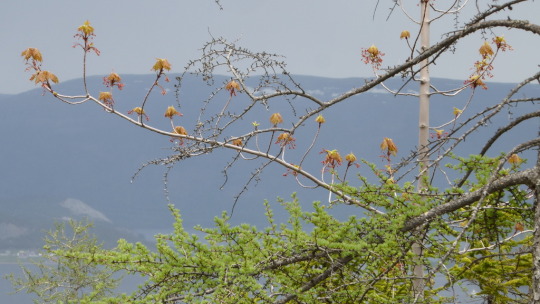
Splashes of color and texture lined the hillside trail.

We took the Lookout Trail to the top of the hill, which was pretty exhausting for both of us, but the views were spectacular.

A lone traveler at the lookout kindly caught a great shot of our sweaty climber look;-)

Spring color came in small but brilliant doses.

Delicate and bright maple leaf starts.

In the evening I decided to try some iceberg ice in Drambuie, my first! All I could think of was the way rice krispies are supposed to act... Snap, Krackle, Pop. It never cracked in to parts, just popped in the liquid all the way to nothing... cool! Oh... the Drambuie wasn’t bad either;-)
We stopped at Waters Edge RV park near Bonne Bay for the night.
June 12th we continued north through the park, picking up walks and hikes along the way.
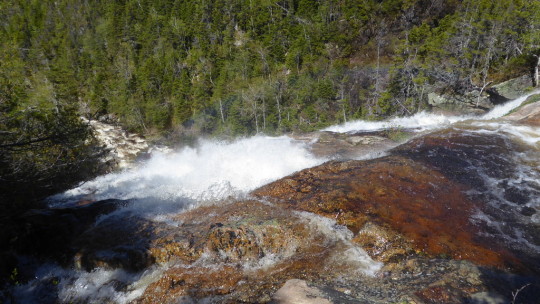
We stopped to walk a short trail to Southeast Brook Falls, quickly leaving the area before road improvement blasting started in 15 minutes.

We stopped in rock harbor to get some fresh water, and toured Lobster Cove Head Lighthouse nearby. The wind was frigid off the ocean, and it apparently never stops.

Along the Bakers Brook Falls trail we ran across a bench that had been delivered in the snow... the easy way:-)

A small pond nearly glowed azure under the clear skies.

The steps to the falls viewpoint were greatly appreciated.

The recent rains had the stepped falls roaring.
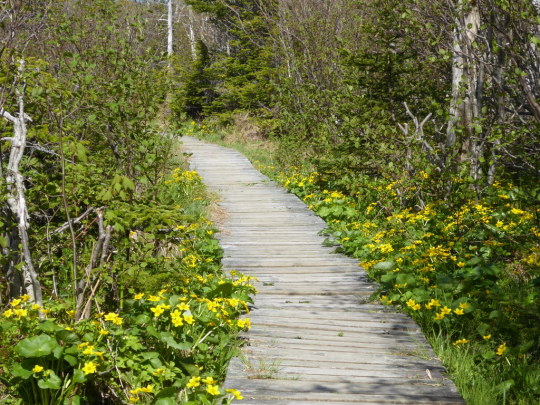
Bright yellow flowers lined much of the wetter parts of the trail, which had several boardwalks that were kilometers long.
We camped at Berry Hill campground to take advantage of the showers after a day of hiking.
June 13th we headed to hike the Western Brook trail.

I only spotted a few stunted trees sporting delicate cone flowers.
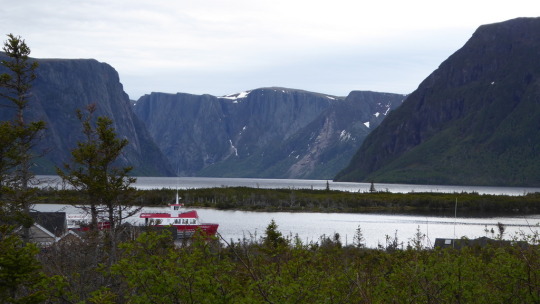
We decided to forgo the $60 boat ride up the lake at the end of the trail, both for cost and lack of reservations, but the views were still gorgeous.

A trail extension to snug harbor required fording a deep, fast, river... not for us.
We continued north to the ferry terminal to Labrador, where we stayed at a town-run RV park so we could clean ourselves and our laundry before taking the ferry.
June 14th we caught the ferry to Labrador.

Here we are in line, ready to drive into the hold via the front door.
We drove to Red Bay, with plans to check it out and head back to catch a return ferry we’d reserved the following day.

The Basque whaling town had 2 excellent museums and a few icebergs in its bay.

An old shipwreck at the mouth of the bay helped archeologists find the wrecked Spanish galleon that provided so much interesting history and artifacts to the museum.
I discovered the brakes were going to the floor as we attempted to leave for our return to the ferry. Looking closely, the driver side brake line had been rubbed so thin the fluid started squirting out under pressure. I panicked as usual, and we had no luck using the phone lent to us by the generous people at the Whalers Restaurant near one of the museums to contact a repair shop.
June 15th, I attempted to patch the line, but the high pressures and lack of anything that would stick to the line led me to failure. Gae, meanwhile, contacted AAA, and arranged for a tow to a shop 15 miles away. We took a walk while waiting for the afternoon tow.

Sleds like this litter the landscape and are used in the winter to haul wood and other material across the area.
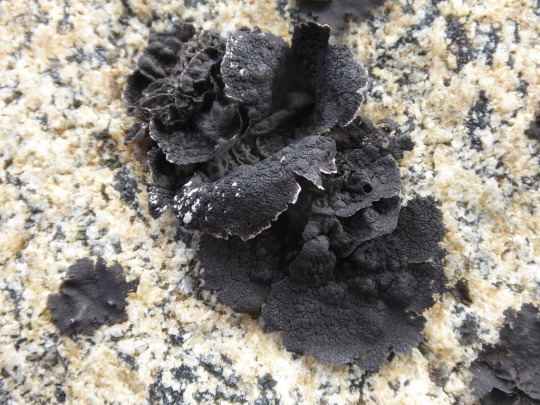
This black lichen decorated many large boulders scattered along the trail we took.

Here I am getting dirty with a fruitless repair.
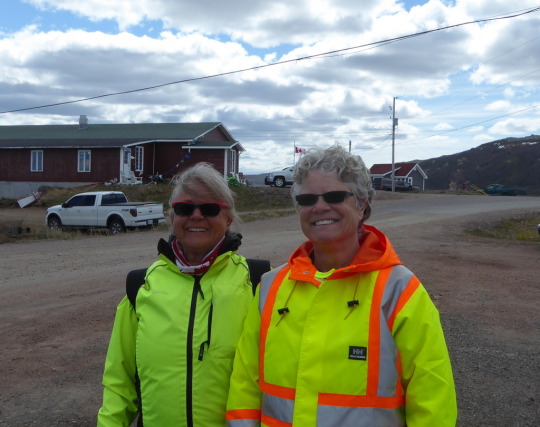
We met a nice bicyclist, Virginia, who’d travelled from St. Catherine near Niagra Falls... we were impressed!

Coastal Motors in Forteau, arrived to save our bacon around 3 in the afternoon, having ordered express delivery of the part in hope of fixing it on the 16th.
We spent the night parked behind their shop. June 16th the part arrived late, and turned out to be for a ‘99 Dodge Ram 3500 truck, which, of course, had completely different connection formats! They were able to sneak in an order for the correct part before the parts place in St. John’s closed. The expected arrival wasn’t until Tuesday, the 20th, so we tucked in for the weekend in Forteau. Akash Gunput, the parts man at Coastal Motors, brought us to his home so we would shower in the evening. We were thrilled to visit and meet his whole family.
June 17th was windy, but not raining, so we took our bikes for a ride to Point Amour Lighthouse, 9 miles away.

Here’s Gae at the point with icebergs behind her. The ride was tough on the pothole ridden highway.
June 18th we stayed close to the van in anticipation of a dinner date with Akash and his family. Again Akash picked us up, and we enjoyed visiting some more and a wonderful dinner prepared by Preety, his wife.

Here his handsome family after a great meal, including Priyanshu, Preety, Akash and Yashveen. Their generosity was hugely appreciated:-)
It’s June 19th and I’m updating this blog, while Gae takes a walk to get her 10K steps. It’s windy and raining and cold again, and we are so thankful Coastal Motors has set us up with an electrical connection while we wait for our part.
99 notes
·
View notes
Photo

Cutting my first rock! I sure do love to find them, and I’ve been wanting to learn how to cut and polish for awhile. Chopped a piece of peridotite with serpentine, hematite and uvarovite garnet that I found in Clear Creek over the winter. https://www.instagram.com/p/B0g2smzh4yp/?igshid=d18rf4ikvfsl
0 notes
Photo

Serpentinized peridotite
72 notes
·
View notes
Photo

Maw Sit Sit
Most gems are metamorphic minerals, and originate in the melting of crustal rocks, either through granites or hydrothermal fluids flowing through the Earth. This electric variety of jade however (though its inclusion in that family is a matter of considerable debate) is a rock, formed by high pressure squeezing of the upper mantle. Its colour comes from Chromium, a metal that also gives us the bright hues of rubies and emeralds (amongst others). The rock is made of several minerals, including the green to black clinopyroxenes jadeite (15%) and kosmochlor (60%).
First described by Edward Gubelin (of the Swiss watches family and gemmological laboratory) in 1963, it has never made it into the wider jewellery market, despite its lush colour. This is because of its rarity, making supply too erratic for jewellery companies. It is only found at one mine and associated river deposits in the Himalayan foothills in the Hpakan/Tawmaw district of northwestern Burma. Jadeite is also mined there, and both gems share a similar origin in high pressure regional metamorphism. Maw Sit Sit however, is much rarer than jadeite. It should not be cleaned in an ultrasonic cleaner or exposed to sudden large temperature changes (putting your cold ring encrusted hand from a wintery outdoors into a hot oven is always a baad idea).
The upper mantle consists of peridotite, an olivine rich rock, which was altered in this case as it was pushed up onto the continent during the subduction of a Jurassic ocean 147 million years ago. These shoved up pieces of mantle and marine crust are called ophiolites. The patterns in the rock come from plastic deformation due to extreme squishing during its journey to the upper crust. The only deposit occurs at the rim of a zone of peridotite that was rich in chromium and altered to serpentine.
As for its inclusion under the jade umbrella, I'd say that the similar origin and jadeite content qualify it. Kosmochlor is a cousin of jadeite, and since a completely different mineral called nephrite also qualifies as jade, I don't see why this lovely rock can't join the family. As they say, if it looks like a duck and quacks like a duck...
The name problem results from the fact that the old Chinese term for jade, Yu, covered a variety of carveable minerals, from amber to jadeite. The imperial green jadeite we now associate with Chinese culture was only discovered in bulk in the 17th century, and most historical artefacts were carved from nephrite. Blessed are those who have a piece of Yu goes the ancient Chinese saying, and with the amazing green beauty and patterns of Maw Sit Sit, I would agree.
Loz
Image credit, 8Cm specimen: James St John. http://www.palagems.com/gem_spectrum3.1.htm http://www.mindat.org/min-42915.html http://gemologyproject.com/wiki/index.php?title=Maw-sit-sit http://www.gemologyonline.com/mawsitsit.html
104 notes
·
View notes
Text
Chromite Market to Record Sturdy Growth by 2025
Chromite is an oxide mineral that belongs to the spinel group. It is one of the important minerals used in the production of metallic chromium. Chromite is also employed as an alloying ingredient in stainless and tool steels. Chromite is an iron chromium oxide commonly associated with olivine, magnetite, serpentine, and corundum. As a major source of metal chromium, the extracted chromium from chromite is used in chrome plating and alloying for production of corrosion resistant superalloys, nichrome, and stainless steel. Chromite is the general name given to chromiumbearing spinels. Chromite is considered the commercial ore mineral of chromium, which is primarily found in ultramafic rocks such as peridotite, dunite, pyroxenite. It is also majorly found in altered derivatives such as serpentinite.
Get sample of this report at: https://www.transparencymarketresearch.com/sample/sample.php?flag=B&rep_id=38693
Chromite deposit can be divided into two main types: stratiform or layered deposits and podiform or alpine type chromite deposit. Stratiform deposits are formed by fractional crystallization of chromite. During this process, chromite spinel is one of the first minerals to crystallize. It sinks and settles within the magma chamber. Under the podiform or alpine type chromite deposit, chromite deposits occur in the form of pods, lenses, and various other types of irregular shapes. Chromite is formed in the upper layer of peridotite, which crystallizes in oceanic lithosphere. This form of chromite can occur in tabular or layer form.
Based on type, the global chromite market can be segmented into high chromium chromite, high iron chromite, and high aluminum chromite. High chromium chromite is one of the important raw materials in the production of stainless steel and similar specialty steel products. High iron chromite is available in granular and powder forms. This type of chromite is not easily soluble in water. High iron chromite is primarily used in the production of chromium base chemicals, low chromium ferrochromium, and refractories. High aluminum chromite is used in manufacturing refractories, magnesite chromite, and chromite magnesite bricks.
Based on application, the global chromite market can be segregated into stainless steel, chemicals, pigments, refractories, and foundry sand. In stainless steel application ferrochrome market drives chromite supply. Production of ferrochrome is considered the primary component in the production of stainless steel. It accounts for approximately 75% share of the global chromite usage. The other 25% share is used in the manufacture of chemicals, pigments (color and corrosion inhibition) and refractories. Chromite ore cannot be substituted in the production of ferrochromium, chromium chemicals, or chromite refractories. In terms of demand, the chromite market has been expanding due to the rise in demand for chromite in ferrochrome, chemical, refractory, and pigment industries.
Based on geography, the global chromite market can be segregated into Asia Pacific, Europe, North America, Latin America, and Middle East & Africa. Middle East & Africa and Asia Pacific are the key regions of the chromite market, led by the growth in the stainless steel industry. Four countries (South Africa, India, Kazakhstan, and Turkey) account for about 80% of the global chromite production. South Africa holds more than 46% share of global production. It is a major supplier of chromite ore and ferrochromium to countries in Europe. Other countries with significant production of chromite include Brazil, Iran, and Madagascar.
Prominent players operating in the global chromite market are Opta Minerals, Inc, LKAB Minerals, CDE Global, and Sibelco. These companies hold significant share of the market. Thus, the chromite market experiences intense competition.
The report offers a comprehensive evaluation of the market. It does so via in-depth qualitative insights, historical data, and verifiable projections about market size. The projections featured in the report have been derived using proven research methodologies and assumptions. By doing so, the research report serves as a repository of analysis and information for every facet of the market, including but not limited to: Regional markets, technology, types, and applications.
0 notes
Text
Chromite Market to Witness Exponential Growth by 2025
Chromite is an oxide mineral that belongs to the spinel group. It is one of the important minerals used in the production of metallic chromium. Chromite is also employed as an alloying ingredient in stainless and tool steels. Chromite is an iron chromium oxide commonly associated with olivine, magnetite, serpentine, and corundum. As a major source of metal chromium, the extracted chromium from chromite is used in chrome plating and alloying for production of corrosion resistant superalloys, nichrome, and stainless steel. Chromite is the general name given to chromiumbearing spinels. Chromite is considered the commercial ore mineral of chromium, which is primarily found in ultramafic rocks such as peridotite, dunite, pyroxenite. It is also majorly found in altered derivatives such as serpentinite.
Read Report Overview @
https://www.transparencymarketresearch.com/chromite-market.html
Chromite deposit can be divided into two main types: stratiform or layered deposits and podiform or alpine type chromite deposit. Stratiform deposits are formed by fractional crystallization of chromite. During this process, chromite spinel is one of the first minerals to crystallize. It sinks and settles within the magma chamber. Under the podiform or alpine type chromite deposit, chromite deposits occur in the form of pods, lenses, and various other types of irregular shapes. Chromite is formed in the upper layer of peridotite, which crystallizes in oceanic lithosphere. This form of chromite can occur in tabular or layer form.
Based on type, the global chromite market can be segmented into high chromium chromite, high iron chromite, and high aluminum chromite. High chromium chromite is one of the important raw materials in the production of stainless steel and similar specialty steel products. High iron chromite is available in granular and powder forms. This type of chromite is not easily soluble in water. High iron chromite is primarily used in the production of chromium base chemicals, low chromium ferrochromium, and refractories. High aluminum chromite is used in manufacturing refractories, magnesite chromite, and chromite magnesite bricks.
Based on application, the global chromite market can be segregated into stainless steel, chemicals, pigments, refractories, and foundry sand. In stainless steel application ferrochrome market drives chromite supply. Production of ferrochrome is considered the primary component in the production of stainless steel. It accounts for approximately 75% share of the global chromite usage. The other 25% share is used in the manufacture of chemicals, pigments (color and corrosion inhibition) and refractories. Chromite ore cannot be substituted in the production of ferrochromium, chromium chemicals, or chromite refractories. In terms of demand, the chromite market has been expanding due to the rise in demand for chromite in ferrochrome, chemical, refractory, and pigment industries.
Based on geography, the global chromite market can be segregated into Asia Pacific, Europe, North America, Latin America, and Middle East & Africa. Middle East & Africa and Asia Pacific are the key regions of the chromite market, led by the growth in the stainless steel industry. Four countries (South Africa, India, Kazakhstan, and Turkey) account for about 80% of the global chromite production. South Africa holds more than 46% share of global production. It is a major supplier of chromite ore and ferrochromium to countries in Europe. Other countries with significant production of chromite include Brazil, Iran, and Madagascar.
Request to view Sample Report:
https://www.transparencymarketresearch.com/sample/sample.php?flag=B&rep_id=38693
Prominent players operating in the global chromite market are Opta Minerals, Inc, LKAB Minerals, CDE Global, and Sibelco. These companies hold significant share of the market. Thus, the chromite market experiences intense competition.
About Us
Transparency Market Research (TMR) is a global market intelligence company providing business information reports and services. The company’s exclusive blend of quantitative forecasting and trend analysis provides forward-looking insight for thousands of decision makers. TMR’s experienced team of analysts, researchers, and consultants use proprietary data sources and various tools and techniques to gather and analyze information.
TMR’s data repository is continuously updated and revised by a team of research experts so that it always reflects the latest trends and information. With extensive research and analysis capabilities, Transparency Market Research employs rigorous primary and secondary research techniques to develop distinctive data sets and research material for business reports.
Contact
Transparency Market Research State Tower, 90 State Street, Suite 700, Albany NY - 12207 United States
Tel: +1-518-618-1030 USA - Canada Toll Free: 866-552-3453 Email: [email protected] Website: http://www.transparencymarketresearch.com
0 notes